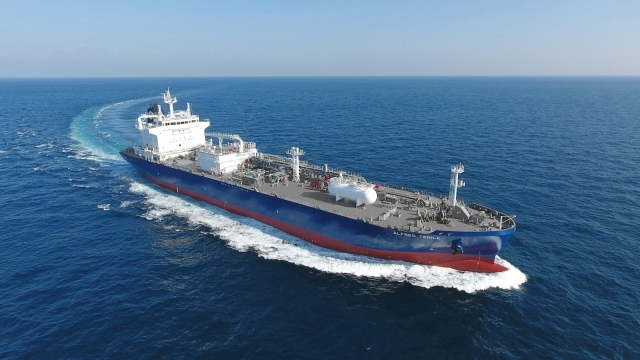Korean shipbuilders account for over 70% of LPG carrier orders
By Yim Hyun-suPublished : May 2, 2021 - 15:27

South Korean shipbuilders are leading the race for liquefied petroleum gas carriers as they have secured over 70 percent of shipbuilding orders this year so far, new data has revealed.
According to shipping and offshore data researcher Clarksons Research on Sunday, a total of 44 LPG-fueled vessels totaling 1.06 million compensated gross tons have been ordered worldwide this year as of late last month.
Among those, South Korean shipbuilders bagged orders that amount to 31 LPG tankers, or nearly 70 percent of all orders that have been placed, the data said.
Last month, Korea Shipbuilding & Offshore Engineering and Daewoo Shipbuilding & Marine Engineering signed deals to build four and two LPG carriers, respectively.
The latest addition combined with the figure from Clarksons Research brings South Korean shipbuilders’ market share up to nearly 74 percent, leaving behind the likes of China and Japan.
When broken down by company, KSOE, an intermediate holding company of Hyundai Heavy Industries Group, secured orders of 28 LPG carriers alone, accounting for more than half of all LPG vessel orders placed this year.
DSME will be tasked to build a total of nine LPG vessels, all of which are considered VLGC -- very large gas carriers, boasting a capacity of over 80,000 cubic meters.
The volume of orders for LPG tankers has been on the rise in recent years, excluding 2020 when the industry suffered a major hit from the coronavirus pandemic. The number stood at 34 ships before it gradually grew to 48 and 65 in the next two years.
Demand for LPG ships is projected to continue to rise, as LPG and liquefied natural gas play the role as a “bridge” in the process of going from fossil fuels to renewable energy.
Seaborne LPG trade is set to rise in volume from 107 million tons this year to 113 million tons in 2020, according to Clarksons Research’s projection.
LPG ships can also use the gas they are carrying as fuel, and many of the recently built LPG ships come with an LPG dual fuel engine to take advantage of the feature.
Experts have said South Korean shipbuilders are likely to benefit from this trend as the industry here has been rushing to develop eco-friendly ships and increase their targets recently.
By Yim Hyun-su (hyunsu@heraldcorp.com)
According to shipping and offshore data researcher Clarksons Research on Sunday, a total of 44 LPG-fueled vessels totaling 1.06 million compensated gross tons have been ordered worldwide this year as of late last month.
Among those, South Korean shipbuilders bagged orders that amount to 31 LPG tankers, or nearly 70 percent of all orders that have been placed, the data said.
Last month, Korea Shipbuilding & Offshore Engineering and Daewoo Shipbuilding & Marine Engineering signed deals to build four and two LPG carriers, respectively.
The latest addition combined with the figure from Clarksons Research brings South Korean shipbuilders’ market share up to nearly 74 percent, leaving behind the likes of China and Japan.
When broken down by company, KSOE, an intermediate holding company of Hyundai Heavy Industries Group, secured orders of 28 LPG carriers alone, accounting for more than half of all LPG vessel orders placed this year.
DSME will be tasked to build a total of nine LPG vessels, all of which are considered VLGC -- very large gas carriers, boasting a capacity of over 80,000 cubic meters.
The volume of orders for LPG tankers has been on the rise in recent years, excluding 2020 when the industry suffered a major hit from the coronavirus pandemic. The number stood at 34 ships before it gradually grew to 48 and 65 in the next two years.
Demand for LPG ships is projected to continue to rise, as LPG and liquefied natural gas play the role as a “bridge” in the process of going from fossil fuels to renewable energy.
Seaborne LPG trade is set to rise in volume from 107 million tons this year to 113 million tons in 2020, according to Clarksons Research’s projection.
LPG ships can also use the gas they are carrying as fuel, and many of the recently built LPG ships come with an LPG dual fuel engine to take advantage of the feature.
Experts have said South Korean shipbuilders are likely to benefit from this trend as the industry here has been rushing to develop eco-friendly ships and increase their targets recently.
By Yim Hyun-su (hyunsu@heraldcorp.com)



![[Exclusive] Korean military set to ban iPhones over 'security' concerns](http://res.heraldm.com/phpwas/restmb_idxmake.php?idx=644&simg=/content/image/2024/04/23/20240423050599_0.jpg&u=20240423183955)




![[Herald Interview] 'Amid aging population, Korea to invite more young professionals from overseas'](http://res.heraldm.com/phpwas/restmb_idxmake.php?idx=644&simg=/content/image/2024/04/24/20240424050844_0.jpg&u=20240424200058)

![[Pressure points] Leggings in public: Fashion statement or social faux pas?](http://res.heraldm.com/phpwas/restmb_idxmake.php?idx=644&simg=/content/image/2024/04/23/20240423050669_0.jpg&u=)








